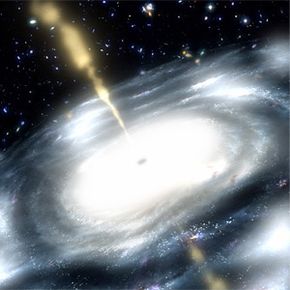Back in Black
Astronomers now believe black holes lie at the centers of most galaxies. They classify these beasts as supermassive black holes because each one may have a maximum mass equivalent to billions of suns. Stellar black holes are the remains of dying stars that have collapsed upon themselves. They're smaller than their supermassive cousins -- the smallest is about 12 miles (19 kilometers) across -- and may be quite common in any galaxy [source: Wethington]. The closest stellar black hole to our solar system is Cygnus X-1, which is about 6,000 light-years away.
Let's say you go to your travel agent and book a one-way flight to an exotic, five-star black hole. You check your luggage, board the rocket and enjoy the ride, trying hard to ignore the screaming kid in the seat behind you. What you see as you approach your final destination depends on what's around the black hole. A companion star located nearby could have its light and gases stripped away and drawn into the neighboring gravity well. Black holes in this situation will often be encircled by an accretion disk, a ring of hot, luminous gas with transitory bright spots similar to solar flares. Even if a black hole resides by itself in a dark corner of the universe, it gives off strong bursts of radiation that your ship's sensors will be able to detect. The bottom line: You'll know exactly when you're getting close.
Advertisement
The captain knows, too, so he or she stops the spacecraft just beyond the black hole's gravitational pull. You'll make the rest of the trip using the jet packs mounted on your spacesuit. You don the suit, exit the vessel and start zipping toward your destiny. Eventually, the black hole's gravity seizes you and begins to reel you in. As you get closer, you orient yourself so you're falling feet-first toward the event horizon.
Brace yourself. On the next page, things get really interesting on our black hole journey.
